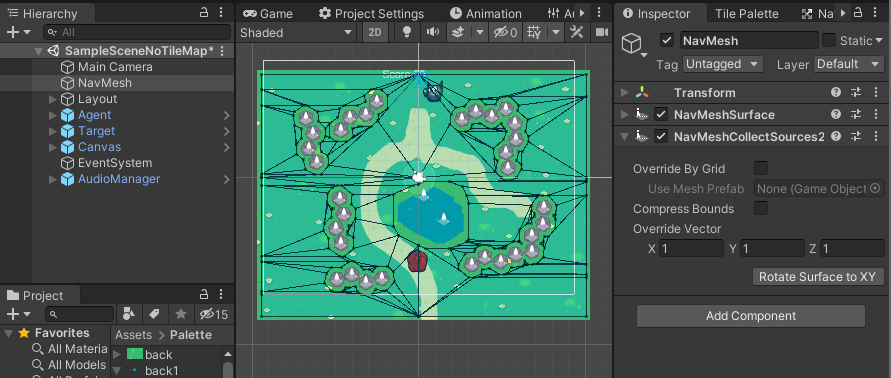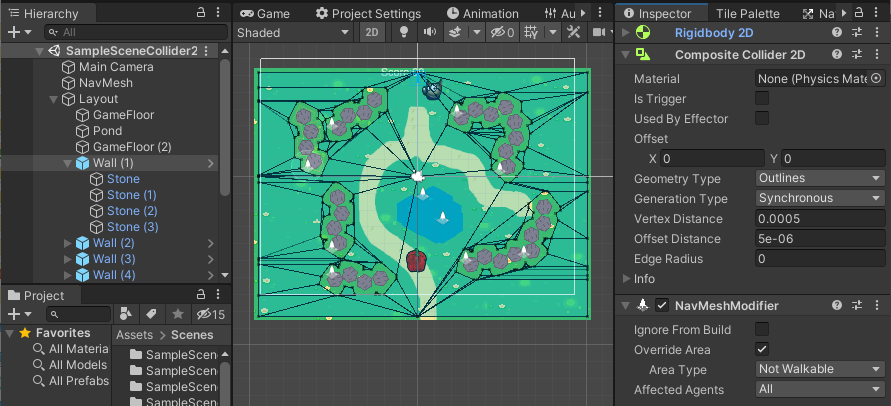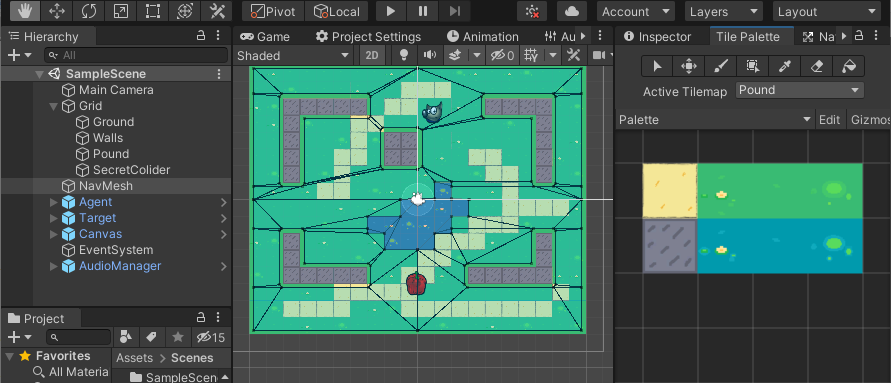-
Notifications
You must be signed in to change notification settings - Fork 205
HOW TO
This short tutorial will focus on achieving the most basic functionality with NavMeshPlus.
To begin with, Create a new project from Unity's "2D Template". Add a Tilemap GameObject to your scene (By right-clicking your Scene hierarchy and choosing the 2D Object folder, and then Tilemap within). The first one you create should simultaneously create a Grid GameObject in the root of your scene and nest your new Tilemap underneath it. Add two more Tilemaps (for a total of 3) and and name them "Ground", "Walls" and "Pond".
Import sprites that will be used as a palette. For example, you could just use 3 solid sold-colored sprites: a green color for ground, a black for walls, and blue for the pond. Create a new palette and drag in your imported sprites.
Using the sprites imported into your palette, choose "Ground" as the Active Tile Map, and then paint the ground into your seen any way you'd like. In our example, we're using the solid "green" brush.
Next, change Active Tile Map in your palette to "Walls". Paint some obstacles. Then select "Pond" and do the same, drawing a body of water.
Download NavMeshPlus and copy NavMeshComponents into your Assets folder. Now, in your scene, right click and choose Create Empty to add an empty GameObject into the root of your scene. Name your new empty GameObject, name it "NavMesh", and rotate it -90, 0, 0.
With your "NavMesh" object selected, in the Inspector click Add Component and choose Nav Mesh Surface 2d. Now select your "Walls" Tilemap GameObject (from within the Grid GameObject), and similarly, Add Component here, too. Choose a Nav Mesh Modifier component.

Go back to your NavMesh and, within the Nav Mesh Surface 2d component section of the inspector, hit Bake.

As you may be able to see, clicking Bake caused the whole scene to be highlighted. Hence, the entire area is considered "walkable" at this point.
Let's override it. In the Nav Mesh Modifier component -- remember, that's on your "Walls" -- check Override Area and in the Area Type field, choose Not Walkable. Now hit Bake again (within the "NavMesh" object). You should see that the Walls you painted have been carved out of the highlighted areas. They are no longer considered "walkable".

Now add a Nav Mesh Modifier Component to your "Pond" Tilemap. Override area like you did with Walls, and choose "Pond" for Area Type. Bake again, and see that the "Pond" is also carved out from your nav mesh.
At this point, you can add GameObjects with a Nav Mesh Agent component, which are capable of interacting with (i.e., walking on) your NavMesh.
Important note: When a "Nav Mesh Agent" starts to interact with your scene (e.g., when they start to move in-game) the system tends to rotate the GameObject upon which the component is placed. This can be undesirable (as in, your object may be rotate away from your plane of view and hence become invisible), so you should fix its rotation by adding something like the following to a new or existing script:
void Start() {
var agent = GetComponent<NavMeshAgent>();
agent.updateRotation = false;
agent.updateUpAxis = false;
}Once this is added to the Start method for all of your agents, you are ready for action.
With new API introduced in Unity 2019.3 there is an ability to choose which geometry source to use. By default Use Geometry option is set to Render Meshes, which mean NavMeshSurface2d use sprite's Mesh to build its navigation surface, so surface will stick to sprite "outline".
The other option available is Physics Colliders, this option allows navmesh to build surface form 2D colliders polygons. To do that place all 2D colliders with NavMeshModifier added into navmesh GameObject as child, change Use Geometry option from Render Meshes to Physics Colliders and hit bake.
Important note: NavMeshSurface2d should be a parent for all colliders if this option enabled. See NON-TILED below
Lets create new "Pound" collider inside Grid object. Add Polygon Collider 2d and NavMeshModifier to it, override its area to "Pound". Now click Edit Collider to make desired pound's shape.

Select "NavMesh" object and change Use Geometry option from Render Meshes to Physics Colliders, click Bake and new Mesh will appear.
"Walls" stay the same, because object had composite collider with exact same box shape as sprite mesh. But "Pound" now shaped not from tilemap sprites, but from Polygon Collider 2D.
Another common task is not to carve out obstacles, but to navigate through a maze, where our agents can only follow a strict path. To do that, Bake your NavMesh with Default Area selected to Not Walkable, and the Nav Mesh Modifier component set to be Walkable, and you will get this:

Any sprite within the Grid object with a Nav Mesh Modifier 2d will be added into Bake process. (Sprite must have a mesh). You can build bridges or barricades, and these objects will be added into your NavMesh as static data.
NavMeshSurface2d can bake objects that are not a part of Tilemap, or even if there is no Tilemap. To do that place all GameObjects with NavMeshModifier that defines your layout as child object to NavMeshSurface2d, and select appropriate option Collect Objects - Children
Important note: Currently there is no way to define world bound except to introduce explicit world bound GameObject with NavMeshModifier
Some games want to use hexagonal, isometric, or diamond-shaped grids. NavMeshPlus supports baking other types of grid as well, as long as spites share the shape as your grid.

In some cases the sprite can differ from your grid shape, it may have excessive outline where we want clean navigation though the tilemap or sprites in hundred different shapes where it tedious to edit each outline. For that case we can override sprite meshes altogether.

We have option to override all tiles within a grid with a prefab. First we need to have a mesh that has the form of a tile. For this hexagonal tile example, we'll import a mesh shaped like a hexagon. (Use Blender or any other 3D software)
Add your hexagon to the scene, rotate it to face the camera and scale it down to match the size of your cells.
In the Nav Mesh Surface 2d component, check Override By Grid and all tiles will have a shape of used prefab. Even if this option disabled, all sprites without a proper mesh will be substituted with this one.

If we remove the prefab and leave the override option, all tiles will be considered as squares.
Often games have procedural world building which requires bake NavMesh at runtime. To achive this call a single method BuildNavMeshAsync inNavMeshSurface2d component to bake NavMesh at runtime in Unity async manner. This method can be called on Start() method.
public NavMeshSurface2d Surface2D;
void Start()
{
Surface2D.BuildNavMeshAsync();
}For dynamic worlds to save some CPU utilization we can call UpdateNavMesh intead of building NavMesh every frame. Code may looks like:
public NavMeshSurface2d Surface2D;
void Update()
{
Surface2D.UpdateNavMesh(surface.navMeshData);
}But it does not cache collected 2D sources beetween updates, so you might use its internal method with your cacheing mechanism:
NavMeshBuilder.UpdateNavMeshDataAsync(data, GetBuildSettings(), sources, sourcesBounds); Important note: Collider's bounds not getting updated to match the transform until 'LateUpdate()' is called. Force the update by calling Physics2D.SyncTransforms() before calling 'BuildNavMesh()' if you baking navmesh at runtime.
Important note: Physics updated only in fixed update, that is running in different time period than regular update. So its is not possible to generate physics in Awake/Start and call 'BuildNavMesh()' before 'LateUpdate()' to bake new geometry at runtime.
More samples can be found in "NavMeshComponents" repository on GitHub
Try out a fully-featured 2D "run-and-chase" game I made to demo NavMesh2d: [RedHotSweetPepper].

References:
- NavMeshSurface - https://docs.unity3d.com/Manual/class-NavMeshSurface.html
- NavMeshSurface2d - https://github.com/h8man/NavMeshPlus
- The Game Demo - https://github.com/h8man/RedHotSweetPepper
- Forum to discuss - https://forum.unity.com/threads/2d-navmesh-pathfinding.503596/
- NavMeshComponents Runtime - https://github.com/Unity-Technologies/NavMeshComponents/tree/master/Assets/Examples/Scenes